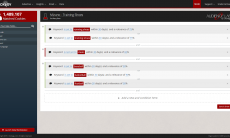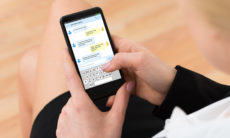Mobile is primarily about the devices and platforms, but mobility is a bigger idea. Mobility is very much at the heart of culture right now. It is about fulfilling consumers’ desire to stay constantly connected and helping people to get tasks done on the move. Mobility in advertising and media is going beyond mobile advertising, to adding mobile functionality and targeting. Nowadays we have seen the whole conversation shift from identifying the touch-points to understanding and participating in talk-points. Mobility is all about a non-stop, multi-directional conversation between people/users/consumers and brands/information/knowledge.
Plus, mobility is all about the shift from personalization to contextualization. Personalization tailors content while contextualization tailors the entire experience–including content–by activating data about the customer’s situation in the physical world. Contextualization utilizes data such as past behavior, past purchases, language, and devices used.
Why should I be interested in mobility?
Global e-commerce sales made via mobile devices are expected to top $638 billion (USD) in 2018, according to a forecast from Goldman Sachs. For perspective, that was roughly the entire size of the world’s e-commerce market in 2013.
Mobile ad spend will continue to track this upward trend in mobile traffic. Data from eMarketer shows that mobile ad spend is on track to rise 75.1%, reaching $31.45 billion, which will make up almost a quarter of overall global digital ad spend. By 2018, global mobile ad spending is projected to reach $94.91 billion.
Consumers spend time researching on mobile; consumers spend more than 15 hours per week on mobile search. The majority of mobile consumers use search in the shopping process. More than 33% of consumers (while in-store) instead of asking an employee for help, search on their mobile devices for information and to read reviews for products they are looking for.
Location proximity matters to mobile consumers. Close proximity to a business is key to conversions: 69% of consumers expect business to be within 5 miles of their location. 71% of consumers used a store locator to find a store.
More than half of mobile consumers want to purchase within an hour. 55% of consumers using mobile to search also want to purchase within the hour.
Mobile research influences purchases decisions: 93% of people who used mobile to research go on to make the purchase.
What am I doing?
All Media is Digital. All Digital is Mobile. Instagram, SnapChat, Flipboard and Waze, whose platforms have mobility at the heart of their proposition, are the hottest and fastest growing media.
Mobility is fueling intelligent marketing. Mobility is paving the way for more intelligent marketing by utilizing the data it collects. FourSquare is somewhat re-inventing itself as a decision-recommendation engine for users and an insight resource for marketers accessing location data they have collected.
Mobility isn’t about what’s happening with devices and setting aside budgets for mobile advertising, but how we bridge mobile to real-world marketing. Mobility is how we take advantage of sharing knowledge, mobile search, location, proximity, and share voiced per brand per location on real time.
How are we doing it?
We have to create a seamless experience across different touch-points. We have consumers who look for information about products on their mobile phones while reading reviews for a competitor’s products and at the same time claiming coupons inside stores driven by iBeacon technology. We need to ensure they can find, feel, start talking with the brand, understand the values of the brand, and get an emotional connection with the brand.
We have to make it easy for consumers not only to purchase quickly on their mobile devices, but also to have the same brand experience across different platforms. Different platforms have to be sensitive to take advantage of location proximity and provide all the right directions to mobile queries.
Why are we doing it?
Hyperconnectivity is increasing digital interconnection of people – and things – anytime and anyplace. By 2020 there will be 50 billion networked devices – such connectivity will increasingly be part of our everyday life: from cars we drive, pills we take, clothes we wear and media we consume to how we work and how countries are governed. Data from these devices will increasingly shape our societies, economies, and our view of the world. Hyperconnected World is a cross-industry, umbrella platform that connects the dots across industry projects to help us understand and manage social, economic and political consequences of digital technology.
Although most online purchases still occur via PCs, Digiday believes commerce will be among the industries most affected by the rise of mobile. Global e-commerce sales made via mobile devices are expected to top $638 billion (USD) in 2018, according to a forecast from Goldman Sachs
Currently, 32% of all online purchases are made with a mobile device.
With something like 86% of mobile time being spent on apps, it only makes sense that many of these purchases are being done through apps. More and more companies are utilizing apps and mobile-optimized websites to allow their customer to pay for goods and services
Position
Mobility is all about making sure that the consumer has the best possible experience when it comes to a brand. Media is the vehicle for that. By making sure the implemented media strategy takes advantage of the multiple screen effect, and by avoiding silo marketing, one understands the shift from personalization to contextualization.
Context becomes more important than ever. Brands not only have to find the best possible way to fit into that context but also to participate into it. We not only know and understand the importance of mobility but also we can deliver the best strategy to increase customer’s experience, enhance the dialogue among different digital and off-line world nomads, and chart the talk-points in order to make sure that our brands know what to say, what to share, how to listen while the conversation is taking place.
Mobility is probably the best way to start understanding the digital anthropological side of consumers interacting with brands and each other in real time. Consumers on mobile are asking for information, forming their opinions of brands, and sharing their experience about them while buying everything with their thumbs.
Sources:
Google, Think Insights
Nielsen
ComScore
Forrester






